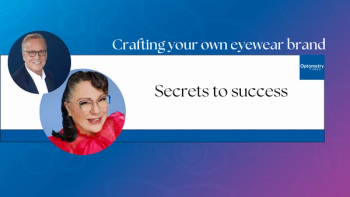
Offer contact lens innovations to your patient
Are we innovating new ideas, products, and systems? If not, what does that hold for the future of our profession? This may not be something that you think much about, but it is the thing which I believe holds the future of optometry in its hands.
Innovation as defined by Wikipedia is a new idea, more effective device or process.1 Innovation can be viewed as the application of better solutions that meet new requirements, inarticulated needs, or existing market needs.2 This is accomplished through more effective products, processes, services, technologies, or ideas that are readily available to markets, governments and society. The term “innovation” can be defined as something original and more effective and, as a consequence, new, that “breaks into” the market or society.3
While a novel device is often described as an innovation, in economics, management science, and other fields of practice and analysis, innovation is generally considered to be a process that brings together various novel ideas in a way that they have an impact on society. Wikipedia goes on to say that innovation in business is the catalyst to growth.
Innovation is the future of optometry
So where does that put us in optometric practice? Are we innovating new ideas, products, and systems? If not, what does that hold for the future of our profession? This may not be something that you think much about, but it is the thing which I believe holds the future of optometry in its hands. I
f we do not keep moving forward with new products, technology, and ideas, we become obsolete. If that happens, then we will go the way our brethren in pharmacy have gone and will be technicians working for corporations.
Related:
Contact lens practice is one of the best examples of changing our habits and introducing innovation to our practice. We commonly have patients come into our office year after year and ask them the same type of questions, such as, “How are your lenses?” What is the answer? “Fine.” So we end up often just keeping the patient in the same lens year after year.4 We abide by the rule of law that has taught us “if it ain’t broke, don’t fix it.”
Well, where has that path led us as a profession? The dropout rate is still 15 to 20 percent, which is the same as 10 years ago.5 Patients are purchasing their contact lenses from alternative sources which were not available 10 years ago. Many in our profession feel that contact lenses are a loss leader and not worth the time.
Vital to the optometric practice
Contact lenses are still a very vibrant part of an optometric practice. Contact lens patients are some of our most loyal and highest referring patients. The key is to make sure we are perceived as vital in the contact lens process. We must learn to break the habits we have tumbled into after years of practice. Just because the patient says her lenses feel “fine,” do not take that to mean everything is great.
Related:
We need to go more into depth about the nature of the patient’s wearing day. Ask more open-ended questions, such as, “How do your lenses feel at the end of the day?” Make sure the patient is experiencing minor irritations she may think are normal.
These are the little things which lead to dropout of patients and loss of revenue to your office. If we just fit the same thing year after year, the patient may come to the conclusion after two or three years that if everything is the same, why shouldn’t she purchase her lenses online and save herself the examination fees?
Habit change is crucial to implement new technology to our practices. We need to repeat a process many times to make it a habit and must make an effort to repeat a new procedure to change the habits which are not good for our practice. We are in a great time for innovation in the contact lens industry.
We have had the most new technologically advanced lens materials we have seen in over 10 years. Now is the time to upgrade our patients into these great new products and achieve a higher level of comfort for our patients.
References:
1. Wikipedia. Available at: https://en.wikipedia.org/wiki/Innovation#cite_note-1. Accessed 7/6/15.
2. Merriam-Webster. Available at: http://www.merriam-webster.com/dictionary/innovation. Accessed 7/6/15.
3. Maranville, S (1992), Entrepreneurship in the Business Curriculum, Journal of Education for Business, Vol. 68 No. 1, pp.27-31.
4. Richdale K, Sinnott LT, Skadahl E, et al. Frequency of and factors associated with contact lens dissatisfaction and discontinuation. Cornea. 2007 Feb;26(2):168-174.
5. Rumpakis J. New data on contact lens dropouts: An international perspective. Rev Optometry. Available at: http://www.revoptom.com/content/d/contact_lenses_and_solutions/c/18929/. Accessed 7/6/15.
Newsletter
Want more insights like this? Subscribe to Optometry Times and get clinical pearls and practice tips delivered straight to your inbox.


















































.png)


